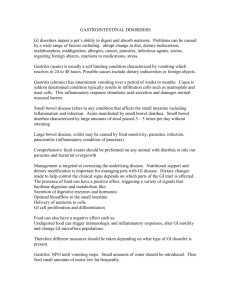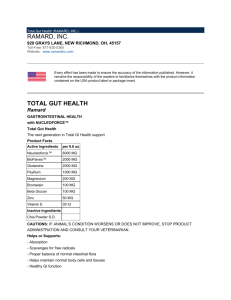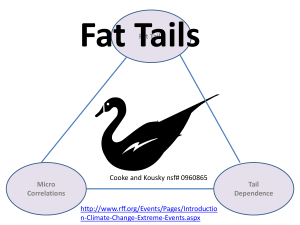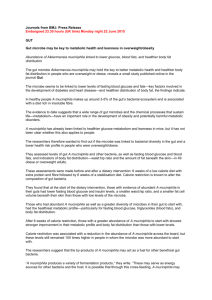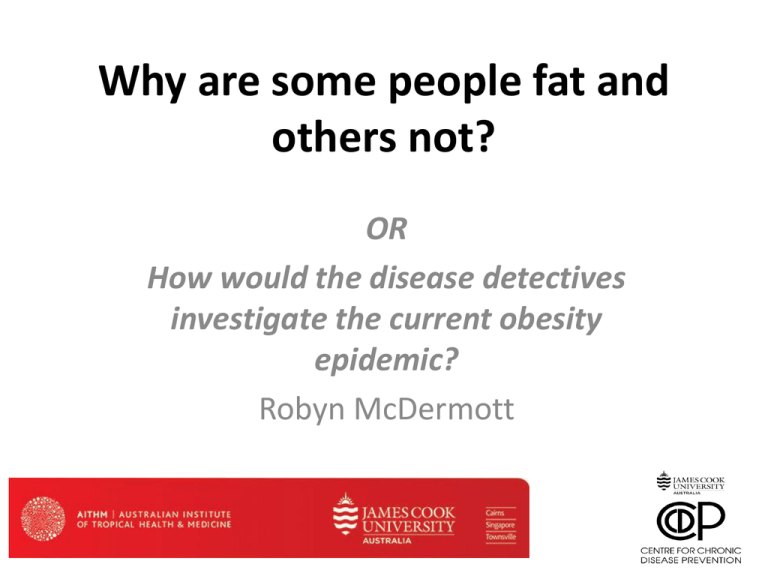
Why are some people fat and
others not?
OR
How would the disease detectives
investigate the current obesity
epidemic?
Robyn McDermott
Investigation of an epidemic
• Who’s got it and who hasn’t
• How are they different? Geography, age, sex,
timing, what they ate and drank, what they
touched…..
• Can we narrow it down to one or two culprits?
• Once we have these, what are the mechanisms?
• Can we stop the epidemic by removing these?
• What if it’s not simple (one bug)?
Classic and simple: John Snow, Cholera and the Broad Street Pump
The fat story: diabesity in the USA
Prevalence of diabetes, Indigenous NQ (WPHC)
and Australia (AusDiab),
1999-2000
60
50
40
Non-Indigenous
Aboriginal
Torres Strait Islander
30
20
10
0
15-24 25-34 35-44 45-54 55-64
Source: McDermott et al, AHR 2003
65+
New and complex: Various theoriesall plausible, all contributing…..
1. Genes, epigenetics, evolution and energy
metabolism: the brown fat story
2. Prenatal exposures and “intrauterine
programming”
3. New foods: fat, sugar and the microbiome
4. New jobs and leisure: screen time, sitting and
sleep deprivation
Human migrations and metabolic adaptation to different environmental
stressors: a new theory for ethnic obesity variation
Source: Sellayah D, et al “On the evolutionary origins of obesity: a new hypothesis. Endocrinology 2014:doi:
10.1210en.2013-2113
Aboriginal adults (Central Australia)
1930s
Torres Strait Islanders, 1930’s-40’s
Ethnic differences in BAT volume and activation:
Caucasians vs South Asians
Source: Bakker LEH et al. Brown adipose tissue volume in healthy lean south Asian adults compared with white Caucasians: a
prospective, case-controlled observational studyThe Lancet Diabetes & Endocrinology, Volume 2, Issue 3, Pages 210 - 217, March
2014
doi:10.1016/S2213-8587(13)70156-6
Fat ain’t fat
The good news: Cold induces brown fat activity and heat production in
lean adults,
but much less so in obese adults (the bad news)
Cold Exposure
Thermoneutral Conditions
Comparative PET–CT scans reveal the patterns of 18F-FDG uptake in the same
subject from the lean group after exposure to cold and under thermoneutral
conditions.
Source: Lichtenbelt et al. Cold-Activated Brown Adipose Tissue in Healthy Men. N Engl J Med 2009;360:1500-8.
Fat ain’t fat: the bad news
Lessons from the microbiome project: You are what you
eat, and so are the friends that live in your gut.
Source: Matthias H Tschöp, Philip Hugenholtz & Christopher L Karp Getting to the core of the gut
microbiome Nature Biotechnology 27, 344 - 346 (2009) doi:10.1038/nbt0409-344
Effect of Intestinal Microbial Ecology on the Developing Brain: What goes in…
Composition of the gut microbiota in a neonate is affected by numerous external and internal factors, beginning at birth.
Source: Martha Douglas-Escobar, MD; Elizabeth Elliott; Josef Neu, MD. Effect of Intestinal Microbial Ecology on the Developing Brain
JAMA Pediatr. 2013;167(4):374-379. doi:10.1001/jamapediatrics.2013.497
Effect of Intestinal Microbial Ecology on the Developing Brain
Martha Douglas-Escobar, Elizabeth Elliott, Josef Neu, JAMA Pediatr. 2013;167(4):374-379.
doi:10.1001/jamapediatrics.2013.497
Enteric nervous system, providing bidirectional communication between gastrointestinal cells and the central nervous
system. Intestinal epithelial cells mediate interactions between gut bacteria and the central nervous system or the immune
system. As bacteria (shown in green) in the intestine come into contact with receptors (shown in black) on the intestinal wall
cell surface, the receptors transmit signals to the central nervous system via the vagus nerve pathways (curved arrow to
central nervous system) and to the immune system (curved arrow) via Toll-like receptor pathways.
So maybe instead of sitting in…..
We should get out more…..






